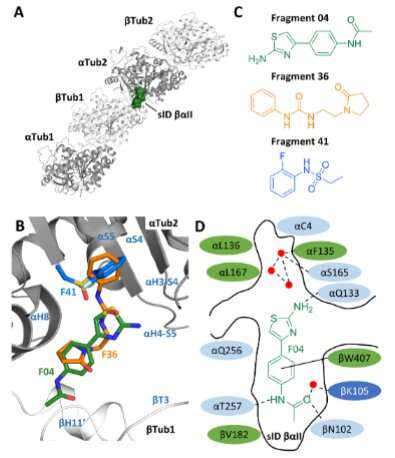Tubulin inhibitor with a unique molecular mechanism of action

Researchers at the Paul Scherrer Institute PSI and the Italian Institute of Technology IIT have developed a novel substance that disables a protein in the cell skeleton, leading to cell death. In this way, substances of this type can prevent, for example, the growth of tumors. To accomplish this, the researchers combined a structural biological method with the computational design of active agents. The study appeared in the journal Angewandte Chemie International Edition.
The cell skeleton, also called the cytoskeleton, pervades all of our cells as a dynamic network of thread-like protein structures. It gives cells their form, aids in the transport of proteins and larger cell components, and plays a crucial role in cell division. The central building block is the protein tubulin. It arranges itself into tube-shaped structures, the microtubule filaments.
Active agents that attach to the cell skeleton are among the most effective drugs against cancer. They block tubulin, and thus prevent cell division in tumors. PSI researchers, in collaboration with the Italian Institute of Technology in Genoa, have now developed another potent substance that disables tubulin. The have dubbed it "Todalam."
"Todalam prevents tubulin from arranging itself in the form of microtubule filaments," explains first author Tobias Mühlethaler, who co-designed and studied the substance as part of his doctoral research at PSI. "The protein remains as if frozen in a structure that doesn't fit into microtubules."
Rationally designed
There are typically two different approaches for developing new drugs: Researchers can test an enormous number of molecules to fish out the ones that appear promising, or they can specifically design chemical molecules that achieve the desired effect. The PSI and IIT researchers chose the second path, which is often more difficult.
In doing this, they were able to build on their own groundwork, research in which they had already located places in tubulin where molecules can dock especially well. These are the so-called binding pockets, of which they found 27. In addition, the researchers identified 56 fragments that bind to these sites. This work, too, had been published earlier in Angewandte Chemie International Edition.
In the current study based on this prior work, the researchers initially selected a newly discovered binding pocket on tubulin. They used computational design to combine the structures of three molecular fragments, which preferentially dock at this point, into a single chemical compound, and then they synthesized it in the laboratory. "By combining the three fragments into one molecule, we hoped to enhance the effect, since the new molecule fills the binding pocket better," says Michel Steinmetz, head of the Laboratory of Biomolecular Research at PSI.
Using measurements at the Swiss Light Source SLS, the researchers checked to see how well the molecule actually fits into the binding pocket. In two further cycles, they improved the substance until they arrived at Todalam. "With relatively simple chemistry, we managed to get to a potent compound," proudly says Andrea Prota, a scientist in the Steinmetz group who collaborated closely with Mühlethaler.
Simple chemical structure
In cell cultures, the researchers demonstrated that Todalam kills cells. No wonder, since tubulin is essential for life. "The better a substance binds to a critical site in tubulin, the more toxic it is for the cells," Steinmetz explains. That makes Todalam a promising starting point for developing a drug.
The cytoskeletal inhibitors currently in clinical use are natural substances with large, complex structures and are therefore difficult to synthesize. The newly developed compound Todalam, on the other hand, can be produced in a simple chemical synthesis in the laboratory. "That also means that the compound could be produced in large quantities relatively easily," Steinmetz stresses.
More information: Tobias Mühlethaler et al, Rational Design of a Novel Tubulin Inhibitor with a Unique Mechanism of Action, Angewandte Chemie International Edition (2022). DOI: 10.1002/anie.202204052
Journal information: Angewandte Chemie International Edition
Provided by Paul Scherrer Institute





















